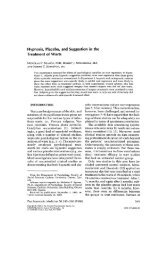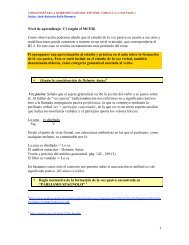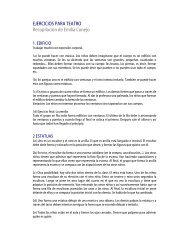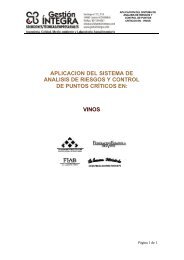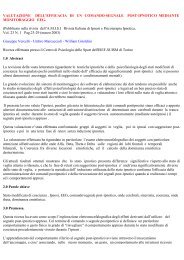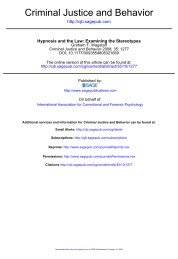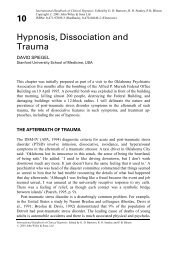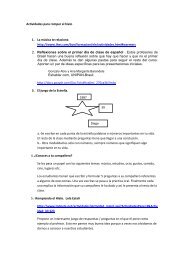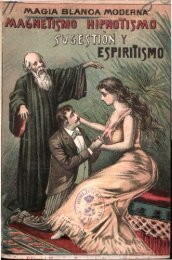<strong>Orne</strong> 1979 IJCEHhttp://www.sas.upenn.edu/psych/history/orne/orneijceh19794311341.html10 de 23 19/03/2012 17:24relevant <strong>and</strong> important, it may be sufficient simply to <strong>in</strong>quire at critical times, "Did you hear anyth<strong>in</strong>g?" <strong>in</strong>order to lead the responsive hypnotized subject to create the desired "memories."Lift<strong>in</strong>g <strong>of</strong> Amnesia versus "Refresh<strong>in</strong>g Memory"Traditionally, <strong>hypnosis</strong> has been a widely <strong>use</strong>d procedure to treat spontaneous amnesia. Similarly, when<strong>hypnosis</strong> has been <strong>use</strong>d to treat324 MARTIN T. ORNEtraumatic neuroses, previously amnesic material would suddenly become accessible to consciousness,usually accompanied by pr<strong>of</strong>ound affect as the patient relives the experience. As abreaction proceeds, thepatient's sudden awareness <strong>of</strong> a myriad <strong>of</strong> details becomes clear from the manner <strong>in</strong> which hereexperiences the events. <strong>The</strong> therapist, seek<strong>in</strong>g to help the patient become aware <strong>of</strong> feel<strong>in</strong>gs, encouragesthe process <strong>of</strong> reexperienc<strong>in</strong>g <strong>and</strong> allows the expression <strong>of</strong> affect to run its course. <strong>The</strong> therapist is carefulto avoid <strong>in</strong>terrupt<strong>in</strong>g the largely spontaneous experience <strong>of</strong> the patient; though he may well want to knowmore about some important details, questions are postponed <strong>in</strong> order not to <strong>in</strong>terfere with the process.It is characteristic <strong>of</strong> repressed memories that they suddenly come to consciousness as an entireexperience rather than emerg<strong>in</strong>g detail by detail. In short, the procedure leads to a narrative exposition asthe patient relives the experience. While there is no certa<strong>in</strong>ty about the historical accuracy <strong>of</strong> thesememories, when they emerge largely spontaneously <strong>and</strong> without undue pressure, they are more likely toconta<strong>in</strong> important <strong>and</strong> accurate <strong>in</strong>formation.S<strong>in</strong>ce these <strong>in</strong>stances <strong>in</strong>volved pathological conditions, the approach--even if legal issues were atstake--was essentially therapeutic, <strong>and</strong> <strong>hypnosis</strong> was carried out by psychologists or psychiatrists <strong>in</strong> thecontext <strong>of</strong> a traditional doctor-patient relationship. In contrast, <strong>hypnosis</strong> has more recently been <strong>use</strong>d <strong>in</strong>circumstances where there is no evidence <strong>of</strong> pathological memory loss. Here, based on the assumptionthat every memory is somehow recorded, <strong>hypnosis</strong> is purported to be simply a means <strong>of</strong> "refresh<strong>in</strong>gmemory." As such, it is claimed that there is no issue <strong>of</strong> therapy <strong>in</strong>volved.As a consequence, hypnotic technique is typically altered to prevent the subject from express<strong>in</strong>g <strong>in</strong>tensefeel<strong>in</strong>gs that would raise therapeutic issues <strong>and</strong> would tend to be frighten<strong>in</strong>g to lay observers. Thus, it issuggested to the subject that he can visualize the events that he seeks to recall on a special televisionscreen; this screen can, as <strong>in</strong> televised sports events, move forward or backward through time, allow<strong>in</strong>gevents to be seen <strong>in</strong> <strong>in</strong>stant replay, slow motion, or frame by frame. Further it is expla<strong>in</strong>ed to the subjectthat he need not experience any discomfort, that he can merely observe the screen <strong>and</strong> see the eventsunfold--as if he were a spectator rather than a participant (e.g., Reiser, 1974). Suggestions are given, suchas, "It is just like watch<strong>in</strong>g a television show except that you not only can see it but you can control <strong>and</strong>even stop the motion; you can be there, but you need not experience pa<strong>in</strong> or fear." S<strong>in</strong>ce hypnoticsubjects who have been emotionally affected are wont to take the opportunity to relive the experience,there is <strong>of</strong>ten some struggle between the hypnotist attempt<strong>in</strong>g to keep the affect bottled up <strong>and</strong> the subjectseek<strong>in</strong>g to express it.325 USE AND MISUSE OF HYPNOSIS IN COURTThis type <strong>of</strong> "objective" reliv<strong>in</strong>g, rather than the "subjective" reliv<strong>in</strong>g generally encouraged by tra<strong>in</strong>edtherapists, seems to br<strong>in</strong>g forth fragmentary recall based not so much on the subject's reliv<strong>in</strong>g theexperience as upon the hypnotist's detailed questions about what is occurr<strong>in</strong>g. Typically, the subject isrepeatedly asked to "stop the film <strong>and</strong> look at the face carefully," <strong>and</strong> is then asked further questionsabout the details <strong>of</strong> the face. <strong>The</strong> same is generally done <strong>in</strong> relation to all potentially important details.S<strong>in</strong>ce this type <strong>of</strong> procedure <strong>in</strong>volves a great many questions about details, it will, <strong>of</strong> course, elicit many
<strong>Orne</strong> 1979 IJCEHhttp://www.sas.upenn.edu/psych/history/orne/orneijceh19794311341.html11 de 23 19/03/2012 17:24more details than a narrative. By the same token, as the work summarized by Hilgard <strong>and</strong> L<strong>of</strong>tus (1979)has <strong>in</strong>dicated, it will result <strong>in</strong> vastly lowered accuracy <strong>of</strong> the material that is obta<strong>in</strong>ed. Further, such aprocedure maximizes the potential <strong>in</strong>put <strong>of</strong> the hypnotist about what is wanted, mak<strong>in</strong>g it even more likelythat the subject's memories will more closely resemble the hypnotist's prior conceptions than wouldord<strong>in</strong>arily be the case.7Unfortunately, no mean<strong>in</strong>gful research is available to document the relative merit <strong>of</strong> facilitat<strong>in</strong>g thereliv<strong>in</strong>g <strong>of</strong> a traumatic event versus the attempt to prevent the affect from be<strong>in</strong>g relived by us<strong>in</strong>g specificsuggestions <strong>and</strong> questions to <strong>in</strong>crease the amount <strong>of</strong> memory-like material be<strong>in</strong>g brought forth.Considerable experience <strong>in</strong> the cl<strong>in</strong>ical <strong>and</strong> forensic <strong>use</strong> <strong>of</strong> age regression <strong>and</strong> related techniques suggeststhat the patient has a higher likelihood <strong>of</strong> produc<strong>in</strong>g uncontam<strong>in</strong>ated memories if allowed to <strong>in</strong>itially relivethe events without much question<strong>in</strong>g by the hypnotist. Further details can then be elicited by question<strong>in</strong>gthe second or third time the material is brought forth. It is <strong>in</strong>terest<strong>in</strong>g that the <strong>in</strong>terrogation techniqueadvocated by L<strong>of</strong>tus (1979), based on an entirely different body <strong>of</strong> data with wak<strong>in</strong>g eyewitnesses, isremarkably similar to that which evolved with hypnotic subjects.<strong>The</strong> Effect <strong>of</strong> the Hypnotic Context on Refresh<strong>in</strong>g <strong>of</strong> MemoryWhile the effect <strong>of</strong> <strong>hypnosis</strong> is most clear-cut <strong>in</strong> the realm <strong>of</strong> memory when one is deal<strong>in</strong>g withcircumscribed areas <strong>of</strong> pathological amnesia, the dramatic lift<strong>in</strong>g <strong>of</strong> amnesia (with which most laymen arefamiliar from its portrayal <strong>in</strong> films, novels, <strong>and</strong> the media), is the exception rather than the rule. With the<strong>in</strong>creas<strong>in</strong>g <strong>use</strong> <strong>of</strong> <strong>hypnosis</strong>, particularly with <strong>in</strong>dividuals without any obvious memory disturbance <strong>and</strong>without the ability to enter pr<strong>of</strong>ound <strong>hypnosis</strong>, the clear demarcation between effects specific to <strong>hypnosis</strong><strong>and</strong> what may occur <strong>in</strong> everyday <strong>in</strong>terroga-7 It is, <strong>of</strong> course, quite <strong>use</strong>ful at times to <strong>use</strong> metaphors such as "stopp<strong>in</strong>g a videotape" <strong>and</strong> "<strong>in</strong>stantreplay" when work<strong>in</strong>g with <strong>hypnosis</strong>. However, no competent hypnotherapist would, <strong>in</strong> us<strong>in</strong>g such ametaphor, conf<strong>use</strong> it with the manner <strong>in</strong> which memory is organized. He would also recognize that he isputt<strong>in</strong>g great pressure on the subject to produce someth<strong>in</strong>g, <strong>and</strong> the greater the pressure, the more likelythe development <strong>of</strong> guided confabulations.326 MARTIN T. ORNEtion with unhypnotized <strong>in</strong>dividuals becomes blurred. While there is no doubt that the k<strong>in</strong>d <strong>of</strong> processes<strong>in</strong>volved <strong>in</strong> <strong>hypnosis</strong> can also be shown to occur under many other circumstances <strong>and</strong> that the basic lawsgovern<strong>in</strong>g human memory are not negated beca<strong>use</strong> the <strong>in</strong>dividual is hypnotized, it would be quite wrong,however, to assume that the hypnotic procedure br<strong>in</strong>gs about no important changes.Some advocates <strong>of</strong> the wide <strong>use</strong> <strong>of</strong> "forensic <strong>hypnosis</strong>" have argued that we need not be concerned aboutthe k<strong>in</strong>ds <strong>of</strong> issues that have been described earlier, beca<strong>use</strong> these problems occur even <strong>in</strong> the wake state<strong>and</strong> are certa<strong>in</strong>ly negligible if the subject is only relaxed <strong>and</strong> not deeply hypnotized. It is ironic that thisk<strong>in</strong>d <strong>of</strong> disclaimer is made by the very <strong>in</strong>dividuals who tout the unique effectiveness <strong>of</strong> <strong>hypnosis</strong> as an aidto crim<strong>in</strong>al <strong>in</strong>vestigation. One cannot have it both ways! <strong>The</strong> reason why <strong>hypnosis</strong> is <strong>use</strong>d as a forensictool is that it is effective <strong>in</strong> elicit<strong>in</strong>g more details. This is so even with <strong>in</strong>dividuals who are not particularlyhypnotizable, but who cooperate <strong>in</strong> the hypnotic situation. It is be<strong>in</strong>g <strong>in</strong> the hypnotic situation itself thatmay pr<strong>of</strong>oundly alter some aspects <strong>of</strong> the subjects' behavior <strong>and</strong> experience (London & Fuhrer, 1961).Thus, there is a strong expectancy that <strong>hypnosis</strong> will facilitate recall. <strong>The</strong> subject <strong>in</strong> the hypnotic situationfeels relaxed <strong>and</strong> less responsible for what he says s<strong>in</strong>ce he believes that the hypnotist is both an expert<strong>and</strong> somehow <strong>in</strong> control. <strong>The</strong> hypnotist <strong>in</strong> turn makes certa<strong>in</strong> that the subject cannot "fail." Hypnotictechnique <strong>in</strong>volves the extensive <strong>use</strong> <strong>of</strong> re<strong>in</strong>forcers through frequent verbalizations, such as, "Good,""F<strong>in</strong>e," "You are do<strong>in</strong>g well," <strong>and</strong> so on, which are novel, satisfy<strong>in</strong>g, <strong>and</strong> reassur<strong>in</strong>g, particularly <strong>in</strong> apolice <strong>in</strong>terrogation situation. Not surpris<strong>in</strong>gly, the subject wants to ma<strong>in</strong>ta<strong>in</strong> the level <strong>of</strong> approbation;consequently, when the hypnotist stops his expressions <strong>of</strong> approval (simply by omitt<strong>in</strong>g to say "Good"), he



